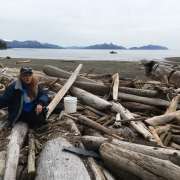
Alaska, nicknamed “The Last Frontier,” is one of the most interesting, and paradoxical, US states. It’s the largest state by area, over twice the square mileage of Texas and four times that of California. And yet, it is less populous than Rhode Island. It has more coastline than all other states combined, with coasts facing the Arctic Ocean, Pacific Ocean, and Bering Sea, but the Nurdle Patrol map has never before displayed surveys from one of its beaches. However, there is someone in this sparse state who happens to know a lot about nurdles, and this year, he reached out to help the Nurdle Patrol.
Scott Walker is a beach pollution researcher and beachcomber in Alaska. Beachcombing is the act of searching a beach or intertidal zone. Scott combs for plastic pollution, including nurdles, and he has been conducting research on the topic for about 30 years. A couple months ago, he contacted Jace Tunnell, reserve director at the University of Texas Marine Science Institute, about gathering Nurdle Patrol data from beaches in Alaska. Since then, he has conducted 7 nurdle surveys. He added his data to the website last week, and they show the sheer amount of nurdles that wash up on Alaskan shores. To figure out how the nurdles got there, we need to get a full picture of Alaska’s fascinating location and landscape.
On America’s Last Frontier, you’ll be hard pressed to find sprawling, sandy beaches. Instead, small “pocket beaches” made up of cobble and gravel sediment lie between rocky headlands. Nurdle collection looks a little different there, too. Scott doesn’t opt to follow the new tide line, as Alaska has dramatic distance between tides. At low tide, the water line may be close to a quarter of a mile away from the debris line. Instead, he searches the nooks and crannies of each pebbled beach. New plastic bits can be found on logs and in cracks, whereas old pieces are often found trapped on one side of the beach. Over time, a “sweet spot” develops, or one area on these rocky pockets where all the plastic pollution amasses. Because of this, beachcombers can find huge amounts of plastic nurdles in one place. In terms of the quantities he has collected, Scott says that “the densest site had an estimated 278,000 nurdles in a square meter of material.” But considering all of Alaska’s emptiness, how did these nurdles end up there?
The truth is, Alaska is a big fish in a big, polluted pond. The Pacific Ocean is the largest ocean in the world, containing infamous areas of concentrated plastic pollution such as the Eastern Garbage Patch, Western Garbage Patch, and Subtropical Convergence Zone. Like its name, the Subtropical Convergence Zone and all prominently polluted areas are zones of “convergence,” where high atmospheric pressures cause currents to spiral inwards. This is how so much garbage builds up, travelling from different parts of the ocean and getting caught there. The upper ocean currents that move through these areas are driven by winds that form two massive oceanic gyres, and the Subtropical Convergence Zone is their meeting place. From here, the current splits into north and south, north being the North Pacific Current, which then transitions into the Alaskan Current in the Gulf of Alaska. Unlike the Garbage Patch, the Gulf of Alaska is a “divergence zone.” Here, sites of low atmospheric pressure push the current, and the trash along with it, out of the spiral and onto the coast. Currents in this rotating system are essentially moving across the Pacific’s polluted zones on a collision course with the Alaskan coastline.
This not only explains why Alaska gets so much plastic pollution, but also why it’s coming from so many places. Scott says every beach contains “pieces of aquaculture gear from Puget Sound to commercial fishing gear from Korea and Japan,” a result of the collection and deposits of circulating currents. This means nurdles are also likely coming from faraway places, not local manufacturers. In fact, the nearest industrial city to Scott’s collection sites is Vancouver, British Columbia, close to 1,000 miles away. Alaska’s nurdle pollution could be coming from the Garbage Patch in the Pacific, cargo ships that send nurdles to processing facilities, or other countries across the ocean. The Last Frontier is truly a special state for nurdle surveys, and Scott’s data offers great insights into the pollution problem faced by Alaska, and the Pacific Ocean as a whole. As Scott sums it up, “if it is dumped in the Pacific Ocean, it will eventually drift into Alaska.”
------------------------------------------------------------------------
About the author: Arya Das is a high school student from the San Francisco Bay Area. She is currently a junior, and plans to major in environmental engineering and work in pollution prevention or renewable energy after college. Arya works with reserve director Jace Tunnell to write articles for the citizen science project Nurdle Patrol.







